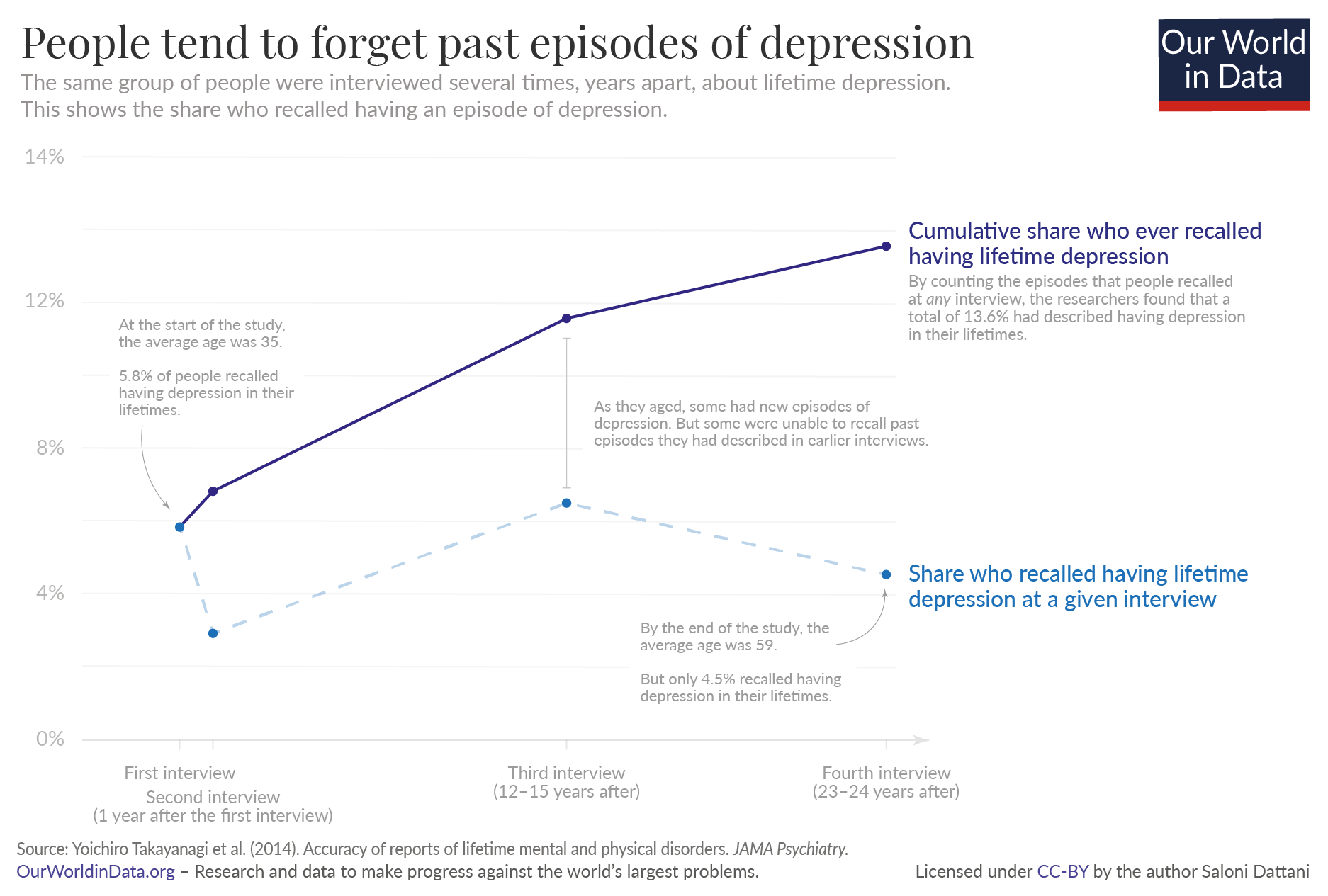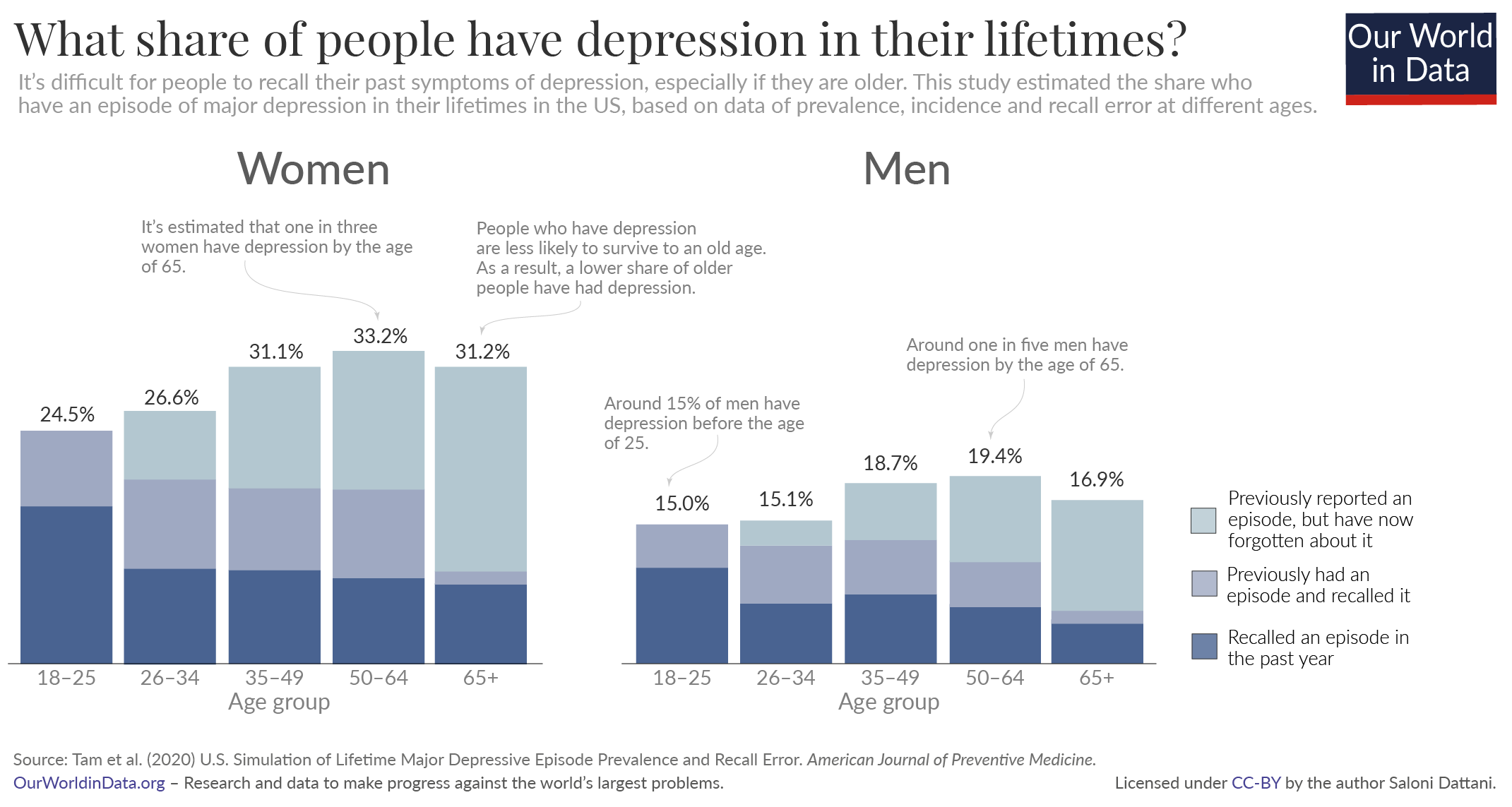What is your lifetime risk of depression?

Depression is one of the most common health conditions globally. It’s estimated that between two to six percent of people in the world have experienced depression in the past year.1
But what are the chances that people have depression at any time in their lives?
This question is difficult to answer because depression is not a constant condition – people tend to transition in and out of depressive episodes. The chances of ever having an episode of depression are therefore much higher than the figure of two to six percent.
Researchers estimate that around one in three women and one in five men in the United States have an episode of major depression by the time they are 65.2 Studies in other high-income countries suggest even higher figures. In the Netherlands and Australia, it’s estimated that this affects 40% of women and 30% of men.3
In this post, I will explain why measuring the lifetime risk of depression can be challenging, and how researchers are able to address the challenges and estimate the risk of major depression over a person’s lifetime.4
Challenges in measuring lifetime depression
One way to estimate the lifetime risk of depression is to ask elderly people whether they have ever had depression in their lives. This sounds straightforward, but it leads to several problems.
One is that it relies on self-reporting. Major depression is diagnosed based on the symptoms that people report to a professional. Since some are unwilling to share these symptoms, we would underestimate the risk of depression if we relied on this information alone.5
This is particularly important for older generations, who lived much of their lives at a time when recognition and acceptance of mental illness was lower. That relates to a second problem: people from different generations might be less willing to report symptoms.6
Another issue is that getting these estimates on a global level is difficult because this data is lacking across many countries. This is especially true for low-income countries.7 For example, the Global Burden of Disease study finds that only a quarter of countries and territories had direct data on the prevalence of major depression between 2005 and 2015.8
This means our findings mostly come from a small number of high-income countries where these studies have been done.
But even in countries where the data does exist, there is yet another major challenge. People often forget about previous episodes of depression – especially if they happened a long time ago. This is called ‘recall bias’, and it is one more problem that makes it hard to rely on people’s self-report of symptoms of depression.
You can see this in the chart. This comes from a large study of people who were interviewed several times, years apart, about symptoms of mental and physical illness they had in their lives.9
Some people described having an episode of depression between one interview and the next. But some failed to recall episodes that they described in earlier interviews. This led to a more or less constant share who described lifetime depression at each interview.
As we might expect, older people were much more likely to forget previous symptoms. People older than 60 were around seven times more likely to forget past episodes than those under 50.
This means we need to be cautious when using data from surveys – without adjusting for this recall bias, we would underestimate the lifetime risk of depression.10

Estimating the lifetime risk of depression
To avoid these problems, researchers can use models to estimate the risk of depression over a person’s lifetime.
They can look at the ages of the people who described an episode of depression in the past year and use this age profile to estimate the cumulative risk over time.11
Studies that used this approach have estimated that the risk of depression by the age of 75 was 30% in the United States in 2005.12
Researchers can also estimate the lifetime risk by estimating the share who have forgotten a past episode of depression. A study by Jamie Tam and colleagues used this approach with more recent data.13 They did this based on people’s self-reports of depression in the past year and in their lifetimes, along with the rates of recall error.
You can see this in the chart. The researchers estimated that one in three women (33%) and one in five men (19%) have major depression by the age of 65 in the United States. With age, the share who have had an episode in the past year declines only slightly. But the share who have forgotten earlier episodes increases steeply.
After the age of 65, the rates of lifetime depression declines, because people who have had depression are less likely to survive to an older age.14
There are also estimates from other high-income countries. For example, a 2005 study that used data from the Netherlands and Australia estimated that 40% of women and 30% of men have an episode of major depression by the age of 65, after correcting for biases.15

What all of these studies agree on is that the lifetime risk of depression is high, and far higher than the estimates made from asking elderly people to recall depression in their lives.
The significant risk of depression over a lifetime is a major reason why it is important to understand, recognize and address. Depression is not uncommon, and people who experience it are not alone.
Yet the risk is not fixed over time. Depression is not inevitable or irreversible. We can strive to prevent it and the impact it has on those who face it.
Republished with permission of Our World In Data under a Creative Commons license. Read the original article.





